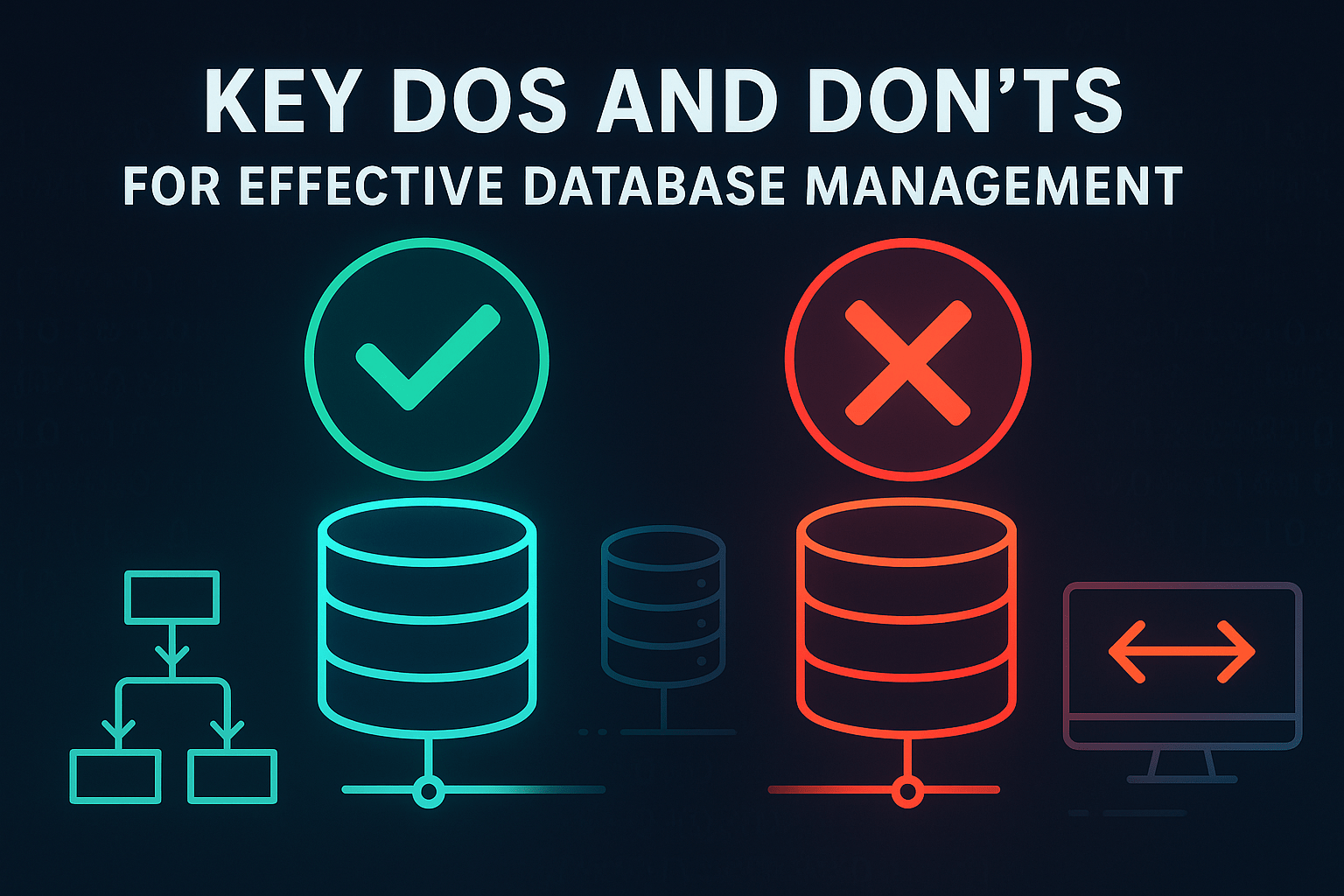Maintaining a high-performance, scalable database requires careful planning and adherence to best practices. Whether you’re managing schema design, database migrations, or compatibility checks, following a set of core principles can prevent common pitfalls and keep your database running smoothly. This post highlights essential do’s and don’ts for database management to guide you in making informed decisions.
The Do’s of Database Management
1. DO Isolate Application Databases
Isolating application databases provides flexibility and control over performance. When each application has its own dedicated database, schema changes can be implemented without impacting other applications, and resource usage is easier to monitor and optimize. Database isolation also improves security by limiting access to a single application, reducing the risk of data breaches.
2. DO Use Explicit Schemas for All Data
Defining explicit schemas is critical for data integrity and maintainability. Explicit schemas specify data structure upfront, enabling validation as data is written. This approach minimizes data inconsistencies, making it easier for developers and analysts to interpret and analyze the data. Schemas also allow you to check for compatibility issues early on, helping maintain stable application performance.
3. DO Automate Schema Migrations
Schema migrations are an inevitable part of database management, and automation reduces the risk of human error. Tools like Liquibase and Flyway allow you to manage schema changes through version-controlled files, making it easier to track modifications over time. Automating migrations also supports rollbacks, enabling you to revert changes if something goes wrong, which helps minimize downtime and data inconsistencies.
4. DO Use Migration Tools to Maintain Schema Compatibility
Automated migration tools can help validate forward and backward compatibility, preventing schema changes from disrupting downstream systems. Compatibility checks can be implemented early in development, ideally as part of a continuous integration process. Tools like schema diff tools can also help identify incompatible changes before deployment, ensuring your schema remains consistent and reliable.
5. DO Define Data Products to Decouple Internal and External Schemas
Data products provide a user-friendly, stable view of data while keeping internal schema changes separate. Creating data products as views or materialized views allows your team to make internal schema updates without breaking data consumers’ workflows. This approach ensures that users have continuous access to reliable data, even as internal data structures evolve.
6. DO Document and Monitor Database Changes
Documentation is crucial for transparency and troubleshooting. By documenting each change to the database—such as schema modifications, migrations, and configuration updates—you enable team members to understand the database’s evolution and quickly address issues. Monitoring database health, including query performance and resource usage, helps you identify bottlenecks and prevent problems before they escalate.
The Don’ts of Database Management
1. DON’T Embed Schemaless Data in Structured Fields
Avoid the temptation to store unstructured data, like JSON, inside schema-based fields. Doing so creates inconsistencies, making it difficult to query and maintain the data. Embedding schemaless data in structured fields often results in performance issues, as the database must parse and interpret different data formats within the same field. Stick to explicit schemas for structured data to ensure reliable performance and readability.
2. DON’T Tie Schema Migrations to Application Deployments
Tying schema changes directly to application deployments can lead to unplanned downtime and performance issues. Schema migrations are delicate processes that should be carefully planned and executed independently of application releases. Running migrations in a controlled environment—such as during scheduled maintenance—helps reduce the risk of breaking application functionality.
3. DON’T Over-Engineer Database Solutions
While planning is essential, avoid over-engineering your database design with unnecessary abstractions or complex architectures. Keep schemas and queries as simple as possible, and adhere to the YAGNI (You Aren’t Gonna Need It) principle. Introducing complexity without a clear purpose often leads to performance issues, technical debt, and a harder-to-maintain database.
4. DON’T Ignore Indexing and Optimization
Poorly optimized databases can lead to performance bottlenecks, especially as data grows. Neglecting indexes, for example, can make query execution much slower. However, avoid over-indexing, as it can increase storage requirements and slow down data writes. Balance indexing with query optimization to achieve optimal performance for both reads and writes.
5. DON’T Ignore Backups Before Critical Changes
Before making significant schema changes, such as dropping tables or altering critical columns, always back up your data. Rollbacks can restore database structure, but they often cannot recover lost data. Backups ensure that you have a recent copy of the data in case an unexpected issue occurs, minimizing the risk of permanent data loss.
6. DON’T Circumvent Migration Tools
Once you’ve chosen a schema migration tool, use it consistently for all database changes. Circumventing the tool by making manual updates directly in the database undermines its tracking capabilities and can result in discrepancies across environments. Using a migration tool consistently keeps your database’s version history intact and ensures all changes are properly documented and reversible.
Building a Reliable Database Management Strategy
Database management is an ongoing effort that requires a balance between flexibility, performance, and stability. By following these do’s and don’ts, you can create a database environment that supports your applications, scales with growth, and maintains data integrity.
Summary Checklist:
- Do’s: Isolate databases, define schemas, automate migrations, maintain compatibility, create data products, document and monitor.
- Don’ts: Avoid embedding schemaless data, separate migrations from deployments, keep solutions simple, optimize indexing, always back up, and use migration tools consistently.
By adhering to these practices, your team can build a resilient database infrastructure that’s easier to manage, scales with your organization’s needs, and supports high-quality, reliable data access for all users.
Conclusion: Enhancing Database Resilience and Usability
Effective database management underpins the success of any data-driven organization. By following these do’s and don’ts, you can avoid common pitfalls, simplify database maintenance, and enable better data access across your organization. Consistent attention to these best practices keeps your database stable, your data secure, and your applications performing at their best.

